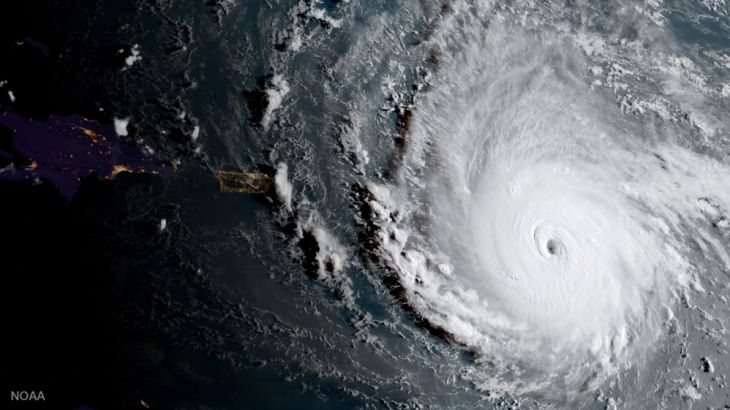Hurricane Irma causes ‘major damage’ in the Caribbean
Category Five storm causes floods and destroys homes in the Caribbean as it heads towards Puerto Rico, Cuba and Haiti.

The strongest Atlantic Ocean hurricane ever measured has slammed into Caribbean islands, causing “major damage” en route to Puerto Rico, the Dominican Republic, Haiti and Cuba before possibly heading for the US state of Florida.
Hurricane Irma caused the death of at least two people in the islands of Saint Barthelemy and Saint Martin, Annick Girardin, the French overseas territories minister, said on Wednesday.
Keep reading
list of 4 itemsScientists say Oman, UAE deluge ‘most likely’ linked to climate change
Photos: Deadly floods wreak havoc in Kenya’s capital
China evacuates over 100,000 as heavy rain continues to lash south
“We’re talking about two dead and two seriously injured for now. Obviously, the situation can change very quickly,” Girardin told reporters before boarding a plane for the region, adding that the powerful storm had destroyed homes and flooded streets.
Located south of the island of Anguilla, Saint Martin – “Sint Maarten” in Dutch – is divided between the France and the Netherlands. Saint Barthelemy, which lies to the southeast of Saint Martin, is administered with the status of a French collectivity, as is the French part of Saint Martin.
READ MORE: Officials warn of ‘powerful’ Hurricane Irma impact
French President Emmanuel Macron warned that the toll would be “harsh and cruel” and that damage on the two islands was “considerable”.
“A national reconstruction plan will be implemented as soon as possible,” Macron said after chairing a crisis meeting in France’s capital, Paris, adding that an emergency fund to finance it would be set up.
![Palm trees in San Juan, Puerto Rico, bend in the wind as Hurricane Irma slammed across northern Caribbean islands [Alvin Baez/Reuters]](/wp-content/uploads/2017/09/e551e8901770446ca3d214fdf39bfa90_18.jpeg)
As the rare Category 5 storm barreled its way across the Caribbean, it brought gusting winds of up to 294 kilometres per hour, weather experts said.
The hurricane made landfall just before 06:00 GMT in Barbuda, part of the twin island nation of Antigua and Barbuda.
There were no immediate reports of casualties.
Garfield Burford, director of news at government-owned broadcaster ABS TV in Antigua and Barbuda, told Al Jazeera that the country has been spared the worse from the “ferocious storm” as emergency services assess damages.
“It was quite a bit of an experience overnight for us, but all things considered Antigua and Barbuda missed a bullet,” he said from Antigua’s capital, Saint John. “It could’ve been much worse.”
Burford added: “There have been a few minor injuries that were treated at the hospital but thankfully, no deaths or serious injuries and that itself is a miracle when you consider the ferocity of the storm.”
‘Historic hurricane’
The French weather office said Irma was “a historic hurricane (with) an unprecedented intensity over the Atlantic”.
With the islands on maximum alert before the arrival of the strongest storm ever recorded in the Atlantic, France had raised the alarm over the fate of some 7,000 people who refused to seek shelter.
“People don’t know phenomena of this scale in this part of the Caribbean,” Girardin said.
Hurricane Irma carries the potential for coastal storm surges of up to six metres above normal tide levels, the Miami-based National Hurricane Centre said on Wednesday.
READ MORE: Harvey exposes Houston’s vulnerability
The National Weather Service said Puerto Rico had not seen a hurricane of Irma’s magnitude since Hurricane San Felipe in 1928, which killed a total of 2,748 people in Guadeloupe, Puerto Rico and Florida.
Warm water is fuel for hurricanes and Irma is over water that is 1C warmer than normal.
The 26C water that hurricanes need goes about 80 metres deep, Jeff Masters, meteorology director of the private forecasting service Weather Underground, told The Associated Press agency.
Its forecast late on Tuesday was for the winds to fluctuate slightly but for the storm to remain at Category 4 or 5 strength for the next day or two.
Dangerous winds
The most dangerous winds, usually nearest to the eye, were forecast to pass near the northern Virgin Islands and near or just north of Puerto Rico through Wednesday.
Al Jazeera’s meteorologist Richard Angwin said: “The movement of the storm is pretty steady at 26km/h and it is going to continue to cross the Caribbean region over the next 24 to 48 hours.”
![Preparations are under way in Miami, Florida as residents brace for Hurricane Irma [Joe Raedle/Getty Images]](/wp-content/uploads/2017/09/320f820ba25845b584ee90cca6f0532e_18.jpeg)
Other islands in the path of Irma include the Virgin Islands and Anguilla, a small, low-lying territory of about 15,000 people.
US President Donald Trump declared emergencies in Florida, Puerto Rico and the US Virgin Islands, and authorities in the Bahamas said they would evacuate six southern islands.
“The dangerousness of this event is like nothing we’ve ever seen,” Ricardo Rossello, Puerto Rico governor, said.
“A lot of infrastructure won’t be able to withstand this kind of force.”
The director of the island’s power company has warned that storm damage could leave some areas without electricity for about a week and other, unspecified areas for four to six months.
“The worst-case scenario for Puerto Rico, in particular, is that if the storm tracks southwards, then the island could get really battered,” said Al Jazeera’s Andy Gallacher, reporting from the capital, San Juan.
|
|